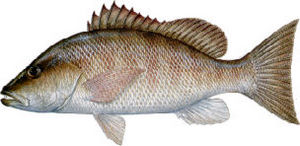The Mangrove Snapper
By Buck Davidson
The wake from the flats boat laps gently among the red mangrove prop roots
as you and your guide round a bend in the channel. The boat slows as you
approach an oyster bar protruding out into the gin-clear water, creating an
undercut ledge some 10-12 feet in depth. Anchoring upcurrent from the
promising-looking hole, you drift weightless live bait into the swirling waters,
watching as your line dips under the rocky embankment. Your bait has
barely left your sight when your rod doubles under the surge of a jarring
strike. After a few minutes of tussling with your quarry, a beautiful 14 inch
fish is hauled aboard. The body glistens silver in the early morning sunlight,
with coffee and mahogany overtones very apparent. The scene repeats itself
several more times before the tidal change signals the end of the bite. Supper
tonight will be nothing short of exquisite – the star attractions are swimming in
the livewell: a half-dozen burly mangrove snapper.
The scientific name for the mangrove snapper is Lutjanus griseus – We’re
not fond of throwing around Latin names here, but this is a fish known by
several common names. Mangrove snapper, gray snapper and mango
snapper are probably the most frequently used – but they also bear some
resemblance to the mahogany snapper, schoolmaster and the white grunt.
Folks also tend to make up their own names for these critters, and some of
them are downright imaginative. Whatever name they go by, mangrove
snappers are a hoot to catch on light tackle and, like most members of the
snapper family – fabulous eating. True to their name, juvenile mangrove
snapper inhabit the backwaters of the mangrove estuaries – lurking amid the
roots and ledges, dashing out to ambush prey. When they begin reaching
adulthood, the snappers move offshore and take up residence near areas of
hard, rocky outcroppings and bottom structure.
Mangrove snapper feed on small fish and crustaceans – they will rarely hit
artificial baits and can be very leader-shy. The big ones, especially, can be
darn finicky about eating your bait. They are very quick and can swipe your
bait in a New York minute, so be prepared to set the hook. Use the smallest
hook and lightest line you can get away with under the conditions – rig your
bait so it will swim as naturally as possible. Chumming is a very good idea
and seems to help the snapper become less wary about chomping your bait
down. Just hang a bag of frozen chum over the side of the boat and let the
current carry the scent and yummy morsels into the snappers’ lair. Set your
bait to drift amid the chum and hang on tight.
Mangrove snapper don’t get huge: 2-5 pounders are prime table fare and
they grow to reach about 15. They are quite common, and are one of those
fish you can invite home for supper and not worry about depleting the stock.
To be legal, a mangrove snapper must be 10 inches in length – there is a 5
fish limit and an aggregate limit on snapper. Best bet is to check the
regulations before you go. But you should definitely go – once you try the
first bite of grilled snapper filet, you’ll be glad you did.
- Jay Mastry - March 26, 2024
- Captains Corner, Gorta - March 23, 2024
- Dave Zalewski - March 12, 2024











